Fracking Fluids and Chemicals Market
Fracking Fluids and Chemicals Market Size and Share Forecast Outlook 2025 to 2035
Fracking fluids and chemicals market is projected to grow from USD 25.0 billion in 2025 to USD 32.0 billion by 2035, at a CAGR of 2.5%. Water-based will dominate with a 72.0% market share, while gelling agents will lead the additive segment with a 32.0% share.
Fracking Fluids and Chemicals Market Forecast and Outlook 2025 to 2035
The fracking fluids and chemicals market stands at the threshold of a decade-long expansion trajectory that promises to reshape unconventional oil and gas extraction technology and hydraulic fracturing solutions. The market's journey from USD 25 billion in 2025 to USD 32 billion by 2035 represents substantial growth, the market will rise at a CAGR of 2.5% which demonstrating the accelerating adoption of advanced fracturing technology and enhanced recovery optimization across shale gas facilities, tight oil operations, and unconventional energy sectors worldwide.
The first half of the decade (2025-2030) will witness the market climbing from USD 25 billion to approximately USD 28.2 billion, adding USD 3.2 billion in value, which constitutes 46% of the total forecast growth period. This phase will be characterized by the rapid adoption of water-based fracturing systems, driven by increasing unconventional production volumes and the growing need for environmentally conscious fracturing solutions worldwide. Enhanced fluid performance capabilities and operational efficiency systems will become standard expectations rather than premium options.
The latter half (2030-2035) will witness continued growth from USD 28.2 billion to USD 32 billion, representing an addition of USD 3.8 billion or 54% of the decade's expansion. This period will be defined by mass market penetration of advanced fracturing technologies, integration with comprehensive reservoir management platforms, and seamless compatibility with existing drilling infrastructure. The market trajectory signals fundamental shifts in how energy facilities approach unconventional extraction and production optimization, with participants positioned to benefit from growing demand across multiple fluid types and application segments.
Quick Stats for Fracking Fluids and Chemicals Market
- Fracking Fluids and Chemicals Market Value (2025): USD 25 billion
- Fracking Fluids and Chemicals Market Forecast Value (2035): USD 32 billion
- Fracking Fluids and Chemicals Market Forecast CAGR: 2.5%
- Leading Fluid Type in Fracking Fluids and Chemicals Market: Water-based Fluids
- Key Growth Regions in Fracking Fluids and Chemicals Market: North America, Middle East, and East Asia
- Top Key Players in Fracking Fluids and Chemicals Market: Halliburton, Schlumberger, Baker Hughes, Liberty Oilfield, C&J Energy
- Where revenue comes from - Now Vs Next (Industry-level view)
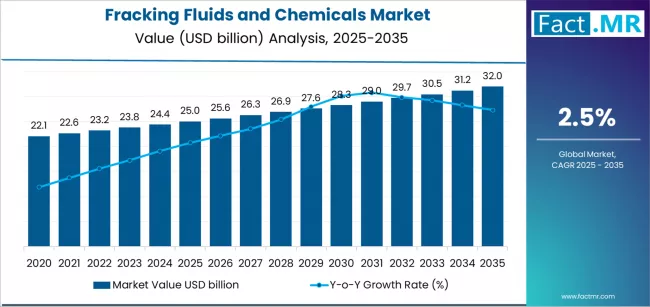
| Period | Primary Revenue Buckets | Share | Notes |
|---|---|---|---|
| Today | Water-based fracturing fluids | 72% | Environmental compliance, cost effectiveness |
| Foam-based systems | 18% | Enhanced proppant transport, gas wells | |
| Oil-based fluid systems | 10% | High-temperature applications, specialized wells | |
| Technical services | 35% | Fluid design, well completion support | |
| Future (3-5 yrs) | Advanced water-based systems | 70-75% | Enhanced environmental profile, performance optimization |
| Hybrid fluid technologies | 15-20% | Combined benefits, application versatility | |
| Specialized chemical additives | 25-30% | Friction reduction, gelling enhancement | |
| Digital fluid management | 10-15% | Real-time monitoring, optimization systems | |
| Environmental compliance services | 12-18% | Regulatory support, waste management | |
| Well completion optimization | 8-12% | Performance enhancement, production maximization |
Fracking Fluids and Chemicals Market Key Takeaways
At-a-Glance Metrics
| Metric | Value |
|---|---|
| Market Value (2025) → | USD 25 billion |
| Market Forecast (2035) ↑ | USD 32 billion |
| Growth Rate ★ | 2.5% CAGR |
| Leading Fluid Type → | Water-based Fluids |
| Primary Application → | Shale Gas Segment |
The market demonstrates strong fundamentals with water-based fluids capturing a dominant share through environmental compatibility and cost-effectiveness for unconventional extraction applications. Shale gas applications drive primary demand, supported by increasing unconventional production and drilling activity requirements. Geographic expansion remains concentrated in established unconventional basins with proven drilling infrastructure, while emerging regions show accelerating adoption rates driven by energy independence initiatives and rising production standards.
Imperatives for Stakeholders in Fracking Fluids and Chemicals Market
Design for environmental compliance, not just performance
- Offer green completion packages: environmentally friendly fluids + regulatory protocols + waste management + technical support + compliance documentation
- Preconfigured solutions: shale gas systems, tight oil applications, coalbed methane operations, and performance optimization for drilling projects
Digital optimization readiness
- Real-time fluid monitoring, automated mixing systems, and drilling operation integration (pressure monitoring, flow rate control)
Performance-by-design approach
- Enhanced fracturing efficiency, environmental impact reduction, regulatory compliance integration, and digital operation documentation
Value-based pricing models
- Clear fluid cost + transparent service tiers (technical support, regulatory compliance, performance optimization); subscriptions for digital services and monitoring
Segmental Analysis
Primary Classification: The market segments by fluid type into water-based, foam-based, and oil-based fracturing fluids, representing the evolution from traditional oil-based systems to environmentally conscious water-based solutions for comprehensive unconventional extraction optimization.
Secondary Classification: Additive segmentation divides the market into gelling agents, friction reducers, biocides, and other chemicals, reflecting distinct requirements for fluid performance, wellbore protection, and operational efficiency standards.
Tertiary Classification: Application segmentation covers shale gas, tight oil, and coalbed methane/other applications, while regional distribution spans North America, Middle East, East Asia, and other global markets with established unconventional drilling infrastructure.
The segmentation structure reveals fluid technology progression from traditional oil-based systems toward sophisticated water-based solutions with enhanced environmental compliance and performance capabilities, while application diversity spans from shale formations to tight oil operations requiring specialized fracturing solutions.
By Fluid Type, the Water-based Fluids Segment Accounts for Dominant Market Share
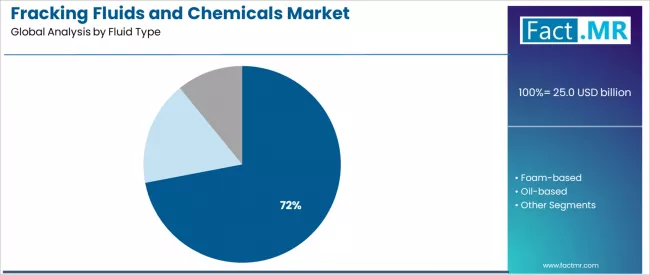
Market Position: Water-based Fluids command the leading position in the fracking fluids and chemicals market with 72% market share through environmental compliance features, including superior environmental profile, cost-effectiveness, and drilling operation optimization that enable energy facilities to achieve optimal fracturing performance across diverse unconventional and conventional environments.
Value Drivers: The segment benefits from energy facility preference for environmentally responsible fracturing systems that provide effective formation stimulation, regulatory compliance, and operational efficiency without requiring significant environmental impact. Advanced water-based features enable reduced environmental footprint, cost optimization, and integration with existing drilling equipment, where environmental compliance and operational performance represent critical project requirements.
Competitive Advantages: Water-based Fluids differentiate through proven environmental compatibility, consistent performance characteristics, and integration with modern drilling systems that enhance project effectiveness while maintaining optimal environmental standards suitable for diverse shale and tight oil applications.
Key market characteristics:
- Advanced water-based designs with optimized environmental profile and fracturing effectiveness capabilities
- Enhanced drilling compatibility, enabling effective formation stimulation with superior environmental characteristics
- Operational integration, including automated mixing systems, real-time monitoring, and performance optimization for fracturing operations
Foam-based Systems Show Specialized Market Performance
Foam-based fracturing systems maintain an 18% market position in the fracking fluids and chemicals market due to their enhanced proppant transport and specialized gas well applications. These systems appeal to operations requiring improved fluid recovery with enhanced formation contact for gas-focused drilling applications. Market adoption is driven by unconventional gas expansion, emphasizing specialized fracturing solutions and operational efficiency through advanced foam technologies.
Oil-based Fluid Systems Demonstrate High-Performance Applications
Oil-based fracturing fluids capture 10% market share through specialized high-temperature requirements in extreme drilling conditions, deep formations, and challenging geological applications. These operations demand robust fluid systems capable of maintaining performance in harsh conditions while providing effective formation stimulation and operational reliability capabilities.
By Additive, the Gelling Agents Segment Shows Market Leadership
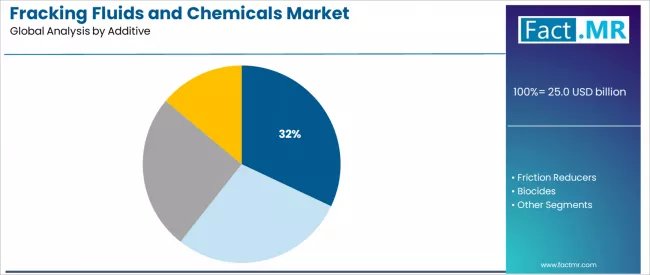
Market Context: Gelling Agents demonstrate the highest market position in the fracking fluids and chemicals market with 32% share due to widespread adoption of viscosity control and increasing focus on proppant transport optimization, fluid efficiency enhancement, and formation contact applications that maximize fracturing effectiveness while maintaining operational standards.
Appeal Factors: Drilling operators prioritize gelling agent reliability, performance consistency, and integration with existing fluid systems that enables coordinated fracturing operations across multiple well stages. The segment benefits from substantial unconventional drilling investment and completion programs that emphasize the implementation of advanced gelling systems for fracturing optimization and production enhancement applications.
Growth Drivers: Unconventional drilling expansion programs incorporate gelling agents as standard fracturing components for formation stimulation, while horizontal drilling growth increases demand for enhanced viscosity capabilities that comply with performance standards and maximize production results.
Market Challenges: Varying geological requirements and fluid compatibility needs may limit standardization across different formations or drilling scenarios.
Application dynamics include:
- Strong growth in shale gas and tight oil drilling requiring comprehensive viscosity management
- Increasing adoption in formation stimulation and production optimization applications for drilling operators
- Rising integration with automated mixing systems for fluid optimization and consistency assurance
Friction Reducers Maintain Critical Performance Demand
Friction reducer applications capture 28% market share through specialized fluid flow requirements in horizontal drilling, extended reach applications, and pumping efficiency optimization. These operations demand effective friction reduction systems capable of enhancing fluid flow while providing operational cost reduction and performance enhancement capabilities.
Biocides Show Essential Protection Applications
Biocides account for 20% market share, including bacterial control, system protection, and fluid quality maintenance requiring chemical treatment capabilities for operational integrity and performance preservation.
By Application, Shale Gas Drives Market Leadership
Market Context: Shale Gas applications dominate the market with 52% share, reflecting the primary demand source for fracturing fluid technology in unconventional gas extraction and production operations.
Business Model Advantages: Shale gas operations provide direct market demand for advanced fracturing fluids, driving technology innovation and performance enhancement while maintaining environmental compliance and operational efficiency requirements.
Operational Benefits: Shale gas applications include formation stimulation, production optimization, and resource extraction that drive consistent demand for fracturing fluids while providing access to latest drilling technologies and techniques.
What are the Drivers, Restraints, and Key Trends of the Fracking Fluids and Chemicals Market?
| Category | Factor | Impact | Why It Matters |
|---|---|---|---|
| Driver | Shale gas production growth & tight oil expansion | ★★★★★ | Increasing unconventional drilling activity drives consistent demand for specialized fracturing fluids and completion chemicals |
| Driver | Technological advancement & horizontal drilling expansion | ★★★★★ | Enhanced drilling techniques require advanced fluid systems; longer horizontal wells need more sophisticated chemical solutions |
| Driver | Energy independence initiatives & domestic production | ★★★★☆ | Government policies promoting domestic energy production increase drilling activity and fracturing fluid demand |
| Restraint | Environmental regulations & water usage concerns | ★★★★☆ | Stricter environmental controls limit operations; water scarcity issues affect fluid availability and increase operational costs |
| Restraint | Oil price volatility & drilling activity fluctuations | ★★★★☆ | Commodity price swings directly impact drilling budgets and chemical purchasing decisions |
| Trend | Green fracturing & environmentally friendly fluids | ★★★★★ | Environmental awareness drives development of biodegradable chemicals and water recycling technologies |
| Trend | Digital optimization & real-time fluid management | ★★★★☆ | Smart drilling technologies enable precise fluid control and optimization, improving efficiency and reducing waste |
Analysis of the Fracking Fluids and Chemicals Market by Key Country
The fracking fluids and chemicals market demonstrates varied regional dynamics with Growth Leaders including USA (2.8% growth rate) and Mexico (2.5% growth rate) driving expansion through unconventional drilling expansion and energy independence initiatives. Steady Performers encompass Germany (2.2% growth rate), France (2.1% growth rate), and UK (2.1% growth rate), benefiting from established energy industries and advanced drilling technology adoption. Emerging Markets feature South Korea (2.1% growth rate) and Japan (2% growth rate), where energy security initiatives and drilling modernization support consistent growth patterns.
Regional synthesis reveals North American markets leading adoption through unconventional energy expansion and drilling optimization, while European countries maintain steady expansion supported by energy technology advancement and regulatory compliance requirements. Asian markets show moderate growth driven by energy security applications and drilling development trends.
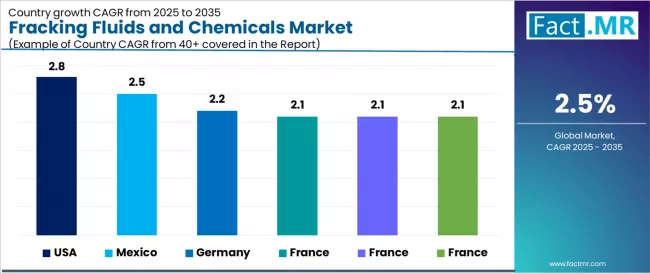
| Region/Country | 2025-2035 Growth | How to win | What to watch out |
|---|---|---|---|
| USA | 2.8% | Focus on environmental compliance | Regulatory changes; water availability |
| Mexico | 2.5% | Offer integrated drilling solutions | Environmental concerns; technical expertise |
| Germany | 2.2% | Provide sustainable fluid systems | Environmental regulations; public opposition |
| France | 2.1% | Lead with green chemistry | Regulatory restrictions; social acceptance |
| UK | 2.1% | Push digital optimization | Environmental policies; operational limitations |
| South Korea | 2.1% | Target energy security sector | Import dependencies; technical requirements |
USA Drives Market Leadership
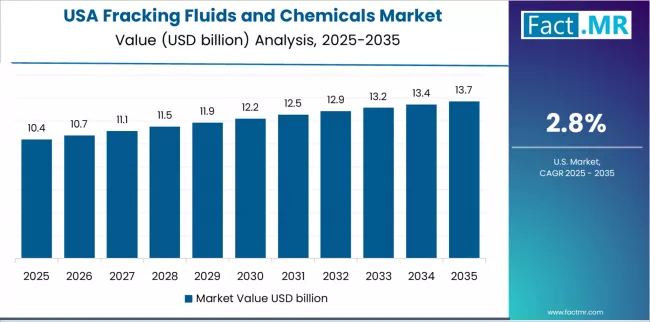
USA establishes market leadership through comprehensive unconventional drilling programs and advanced energy infrastructure development, integrating fracking fluids and chemicals across shale gas and tight oil applications. The country's 2.8% growth rate reflects established energy industry relationships and mature fracturing technology adoption that supports widespread use of water-based systems in unconventional drilling and horizontal completion facilities. Growth concentrates in major shale basins, including Permian Basin, Eagle Ford, and Bakken, where drilling technology showcases mature fracturing deployment that appeals to energy operators seeking proven formation stimulation capabilities and production optimization applications.
American service companies leverage established distribution networks and comprehensive technical capabilities, including fluid design programs and completion services that create customer relationships and operational advantages. The market benefits from mature drilling standards and energy regulations that encourage fracturing fluid system use while supporting technology advancement and environmental optimization.
Strategic Market Indicators:
- Unconventional drilling and completion facilities maintaining 78% adoption rate with comprehensive fracturing fluid deployment
- Established EPA compliance standards providing consistent demand for environmentally friendly fracturing technology advancement
- Service company networks capturing 65% market share through operational flexibility and technical expertise
- Technology integration programs expanding fracturing capabilities in drilling scenarios
Mexico Shows Strong Regional Growth
Mexico's market expansion benefits from diverse energy demand, including unconventional exploration and drilling modernization that increasingly incorporate fracturing solutions for production enhancement applications. The country maintains a 2.5% growth rate, driven by rising drilling activity and increasing recognition of unconventional resource benefits, including enhanced energy security and production optimization.
Market dynamics focus on integrated drilling solutions that balance advanced fracturing performance with technical expertise considerations important to Mexican energy operators. Growing energy sector development creates continued demand for modern fracturing systems in new drilling infrastructure and completion modernization projects.
Germany Maintains Technology Leadership
Germany's advanced energy market demonstrates sophisticated fracking fluids and chemicals consideration with documented environmental effectiveness in potential unconventional applications and drilling technology research through integration with existing energy systems and regulatory infrastructure. The country leverages engineering expertise in energy technology and environmental systems integration to maintain a 2.2% growth rate. Research centers showcase premium development where fracturing technologies integrate with comprehensive environmental platforms and regulatory management systems to optimize performance operations and environmental compliance.
German companies prioritize system sustainability and EU compliance in fracturing fluid development, creating demand for environmentally responsible systems with advanced features, including environmental monitoring integration and comprehensive regulatory systems. The market benefits from established energy technology infrastructure and a commitment to invest in sustainable fracturing technologies that provide long-term environmental benefits and compliance with international energy standards.
France Shows Regulatory Market Development
France maintains steady market consideration through established energy programs and environmental compliance modernization, exploring fracking fluids and chemicals in research and potential unconventional applications. The country's 2.1% growth rate reflects comprehensive energy industry support and mature environmental adoption that promotes research into environmentally responsible fracturing systems in energy technology and environmental research facilities.
French facilities prioritize fracturing system environmental compatibility and EU regulatory compliance, creating demand for sustainable systems with proven environmental performance and comprehensive regulatory documentation. The market benefits from established energy infrastructure and government support for clean energy development that encourages fracturing research advancement.
UK Demonstrates Market Innovation
UK's energy market showcases innovative fracking fluids and chemicals research with 2.1% growth rate through comprehensive energy programs and environmental compliance initiatives. The country benefits from established energy technology infrastructure and regulatory expertise that supports fracturing system research across potential unconventional applications.
Market development focuses on digital optimization and environmental fracturing solutions that align with UK energy industry modernization programs. Regulatory considerations create opportunities for advanced fracturing technology development while maintaining strict environmental compliance standards.
South Korea Emerges as Energy Security Market
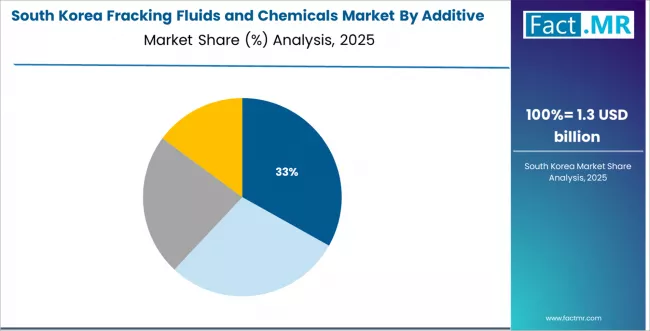
South Korea establishes market position through energy security development and drilling technology research, considering fracking fluids and chemicals as potential energy independence components in research and technology installations. The country's 2.1% growth rate reflects government initiatives promoting energy technology advancement and domestic energy capabilities that support advanced fracturing research systems.
Korean companies are developing innovative fracturing solutions that combine domestic technology advantages with international environmental standards, including digital monitoring and enhanced sustainability capabilities. Government support for energy security development supports research across diverse energy technology and drilling segments.
Europe Market Split by Country
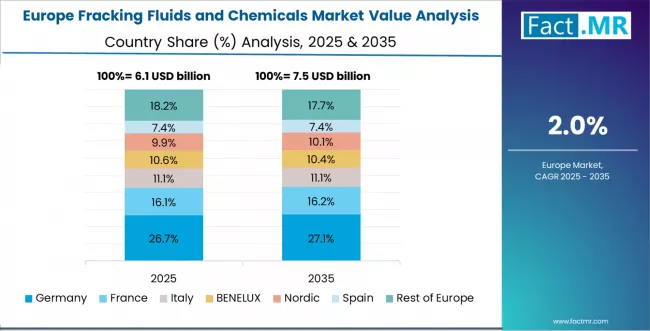
The European fracking fluids and chemicals market is projected to grow from USD 3.8 billion in 2025 to USD 4.9 billion by 2035, registering a CAGR of 2.3% over the forecast period. Germany is expected to maintain its leadership position with a 28.9% market share in 2025, supported by its advanced energy technology infrastructure and major research centers.
United Kingdom follows with a 26.3% share in 2025, driven by comprehensive energy programs and fracturing technology development initiatives. France holds a 23.7% share through specialized energy applications and environmental compliance requirements. Italy commands a 12.6% share, while Spain accounts for 8.5% in 2025. The rest of Europe region is anticipated to gain momentum, expanding its collective share from 5.8% to 6.2% by 2035, attributed to increasing energy technology adoption in Nordic countries and emerging facilities implementing energy modernization programs.
Competitive Landscape of the Fracking Fluids and Chemicals Market
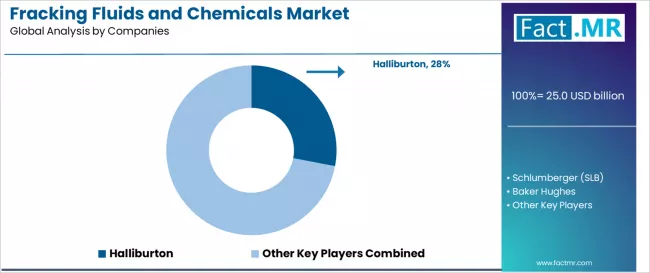
- Structure: ~15-20 credible players; top 3-5 hold ~60-65% by revenue
- Leadership is maintained through: service networks, technical expertise, and technology innovation (environmental compliance + performance + cost efficiency)
- What's commoditizing: basic water-based fluids and standard chemical additives
- Margin Opportunities: technical services, environmental compliance, and integration into drilling workflows (digital monitoring, performance optimization)
| Stakeholder | What they actually control | Typical strengths | Typical blind spots |
|---|---|---|---|
| Global service platforms | Service networks, technical expertise, comprehensive solutions | Broad basin coverage, proven performance, integrated services | Environmental compliance costs; regional adaptation |
| Technology innovators | R&D capabilities; advanced fluid systems; digital integration | Latest technology first; superior performance and environmental profile | Service density outside core basins; cost competitiveness |
| Regional specialists | Local expertise, basin knowledge, rapid response | "Close to wellsite" service; basin-specific solutions; competitive pricing | Technology gaps; talent retention in technical service |
| Chemical suppliers | Raw materials, specialty additives, supply chain | Consistent supply; competitive materials cost; product innovation | Service complexity; direct customer relationships |
| Environmental specialists | Compliance expertise, waste management, regulatory support | Win environmentally sensitive projects; regulatory knowledge | Scale limitations; technology development resources |
Key Players in the Fracking Fluids and Chemicals Market
- Halliburton
- Schlumberger (SLB)
- Baker Hughes
- Liberty Oilfield Services
- C&J Energy Services
- Trican Well Service
- Calfrac Well Services
- CES Energy Solutions
- Weatherford International
- Dow Chemicals
Scope of the Report
| Item | Value |
|---|---|
| Quantitative Units | USD 25 billion |
| Fluid Type | Water-based, Foam-based, Oil-based |
| Additive | Gelling Agents, Friction Reducers, Biocides, Others |
| Application | Shale Gas, Tight Oil, Coalbed Methane/Others |
| Regions Covered | North America, Latin America, Europe, East Asia, South Asia Pacific, Middle East & Africa |
| Countries Covered | United States, Germany, United Kingdom, France, Japan, China, South Korea, Mexico, India, Canada, and 25+ additional countries |
| Key Companies Profiled | Halliburton, Schlumberger, Baker Hughes, Liberty Oilfield Services, C&J Energy Services, Trican Well Service, Calfrac Well Services, CES Energy Solutions, Weatherford International, Dow Chemicals |
| Additional Attributes | Dollar sales by fluid type and additive categories, regional adoption trends across North America, Europe, and East Asia, competitive landscape with oilfield service companies and chemical suppliers, drilling operator preferences for environmental compliance and performance optimization, integration with drilling platforms and monitoring systems, innovations in fracturing technology and chemical enhancement, and development of sustainable solutions with enhanced performance and environmental optimization capabilities. |
Fracking Fluids and Chemicals Market by Segments
-
Fluid Type:
- Water-based
- Foam-based
- Oil-based
-
Additive:
- Gelling Agents
- Friction Reducers
- Biocides
- Others
-
Application:
- Shale Gas
- Tight Oil
- Coalbed Methane/Others
-
Region:
- North America
- United States
- Canada
- Mexico
- Latin America
- Brazil
- Argentina
- Rest of Latin America
- Europe
- Germany
- United Kingdom
- France
- Italy
- Spain
- Nordic
- BENELUX
- Rest of Europe
- East Asia
- China
- Japan
- South Korea
- South Asia Pacific
- India
- ASEAN
- Australia & New Zealand
- Rest of South Asia Pacific
- Middle East & Africa
- Kingdom of Saudi Arabia
- Other GCC Countries
- Turkey
- South Africa
- Other African Union
- Rest of Middle East & Africa
- North America
Table of Content
- Executive Summary
- Global Market Outlook
- Demand to side Trends
- Supply to side Trends
- Technology Roadmap Analysis
- Analysis and Recommendations
- Market Overview
- Market Coverage / Taxonomy
- Market Definition / Scope / Limitations
- Market Background
- Market Dynamics
- Drivers
- Restraints
- Opportunity
- Trends
- Scenario Forecast
- Demand in Optimistic Scenario
- Demand in Likely Scenario
- Demand in Conservative Scenario
- Opportunity Map Analysis
- Product Life Cycle Analysis
- Supply Chain Analysis
- Investment Feasibility Matrix
- Value Chain Analysis
- PESTLE and Porter’s Analysis
- Regulatory Landscape
- Regional Parent Market Outlook
- Production and Consumption Statistics
- Import and Export Statistics
- Market Dynamics
- Global Market Analysis 2020 to 2024 and Forecast, 2025 to 2035
- Historical Market Size Value (USD Million) Analysis, 2020 to 2024
- Current and Future Market Size Value (USD Million) Projections, 2025 to 2035
- Y to o to Y Growth Trend Analysis
- Absolute $ Opportunity Analysis
- Global Market Pricing Analysis 2020 to 2024 and Forecast 2025 to 2035
- Global Market Analysis 2020 to 2024 and Forecast 2025 to 2035, By Fluid Type
- Introduction / Key Findings
- Historical Market Size Value (USD Million) Analysis By Fluid Type , 2020 to 2024
- Current and Future Market Size Value (USD Million) Analysis and Forecast By Fluid Type , 2025 to 2035
- Water-based
- Foam-based
- Oil-based
- Y to o to Y Growth Trend Analysis By Fluid Type , 2020 to 2024
- Absolute $ Opportunity Analysis By Fluid Type , 2025 to 2035
- Global Market Analysis 2020 to 2024 and Forecast 2025 to 2035, By Additive
- Introduction / Key Findings
- Historical Market Size Value (USD Million) Analysis By Additive, 2020 to 2024
- Current and Future Market Size Value (USD Million) Analysis and Forecast By Additive, 2025 to 2035
- Gelling Agents
- Friction Reducers
- Biocides
- Others
- Y to o to Y Growth Trend Analysis By Additive, 2020 to 2024
- Absolute $ Opportunity Analysis By Additive, 2025 to 2035
- Global Market Analysis 2020 to 2024 and Forecast 2025 to 2035, By Region
- Introduction
- Historical Market Size Value (USD Million) Analysis By Region, 2020 to 2024
- Current Market Size Value (USD Million) Analysis and Forecast By Region, 2025 to 2035
- North America
- Latin America
- Western Europe
- Eastern Europe
- East Asia
- South Asia and Pacific
- Middle East & Africa
- Market Attractiveness Analysis By Region
- North America Market Analysis 2020 to 2024 and Forecast 2025 to 2035, By Country
- Historical Market Size Value (USD Million) Trend Analysis By Market Taxonomy, 2020 to 2024
- Market Size Value (USD Million) Forecast By Market Taxonomy, 2025 to 2035
- By Country
- USA
- Canada
- Mexico
- By Fluid Type
- By Additive
- By Country
- Market Attractiveness Analysis
- By Country
- By Fluid Type
- By Additive
- Key Takeaways
- Latin America Market Analysis 2020 to 2024 and Forecast 2025 to 2035, By Country
- Historical Market Size Value (USD Million) Trend Analysis By Market Taxonomy, 2020 to 2024
- Market Size Value (USD Million) Forecast By Market Taxonomy, 2025 to 2035
- By Country
- Brazil
- Chile
- Rest of Latin America
- By Fluid Type
- By Additive
- By Country
- Market Attractiveness Analysis
- By Country
- By Fluid Type
- By Additive
- Key Takeaways
- Western Europe Market Analysis 2020 to 2024 and Forecast 2025 to 2035, By Country
- Historical Market Size Value (USD Million) Trend Analysis By Market Taxonomy, 2020 to 2024
- Market Size Value (USD Million) Forecast By Market Taxonomy, 2025 to 2035
- By Country
- Germany
- UK
- Italy
- Spain
- France
- Nordic
- BENELUX
- Rest of Western Europe
- By Fluid Type
- By Additive
- By Country
- Market Attractiveness Analysis
- By Country
- By Fluid Type
- By Additive
- Key Takeaways
- Eastern Europe Market Analysis 2020 to 2024 and Forecast 2025 to 2035, By Country
- Historical Market Size Value (USD Million) Trend Analysis By Market Taxonomy, 2020 to 2024
- Market Size Value (USD Million) Forecast By Market Taxonomy, 2025 to 2035
- By Country
- Russia
- Poland
- Hungary
- Balkan & Baltic
- Rest of Eastern Europe
- By Fluid Type
- By Additive
- By Country
- Market Attractiveness Analysis
- By Country
- By Fluid Type
- By Additive
- Key Takeaways
- East Asia Market Analysis 2020 to 2024 and Forecast 2025 to 2035, By Country
- Historical Market Size Value (USD Million) Trend Analysis By Market Taxonomy, 2020 to 2024
- Market Size Value (USD Million) Forecast By Market Taxonomy, 2025 to 2035
- By Country
- China
- Japan
- South Korea
- By Fluid Type
- By Additive
- By Country
- Market Attractiveness Analysis
- By Country
- By Fluid Type
- By Additive
- Key Takeaways
- South Asia and Pacific Market Analysis 2020 to 2024 and Forecast 2025 to 2035, By Country
- Historical Market Size Value (USD Million) Trend Analysis By Market Taxonomy, 2020 to 2024
- Market Size Value (USD Million) Forecast By Market Taxonomy, 2025 to 2035
- By Country
- India
- ASEAN
- Australia & New Zealand
- Rest of South Asia and Pacific
- By Fluid Type
- By Additive
- By Country
- Market Attractiveness Analysis
- By Country
- By Fluid Type
- By Additive
- Key Takeaways
- Middle East & Africa Market Analysis 2020 to 2024 and Forecast 2025 to 2035, By Country
- Historical Market Size Value (USD Million) Trend Analysis By Market Taxonomy, 2020 to 2024
- Market Size Value (USD Million) Forecast By Market Taxonomy, 2025 to 2035
- By Country
- Kingdom of Saudi Arabia
- Other GCC Countries
- Turkiye
- South Africa
- Other African Union
- Rest of Middle East & Africa
- By Fluid Type
- By Additive
- By Country
- Market Attractiveness Analysis
- By Country
- By Fluid Type
- By Additive
- Key Takeaways
- Key Countries Market Analysis
- USA
- Pricing Analysis
- Market Share Analysis, 2024
- By Fluid Type
- By Additive
- Canada
- Pricing Analysis
- Market Share Analysis, 2024
- By Fluid Type
- By Additive
- Mexico
- Pricing Analysis
- Market Share Analysis, 2024
- By Fluid Type
- By Additive
- Brazil
- Pricing Analysis
- Market Share Analysis, 2024
- By Fluid Type
- By Additive
- Chile
- Pricing Analysis
- Market Share Analysis, 2024
- By Fluid Type
- By Additive
- Germany
- Pricing Analysis
- Market Share Analysis, 2024
- By Fluid Type
- By Additive
- UK
- Pricing Analysis
- Market Share Analysis, 2024
- By Fluid Type
- By Additive
- Italy
- Pricing Analysis
- Market Share Analysis, 2024
- By Fluid Type
- By Additive
- Spain
- Pricing Analysis
- Market Share Analysis, 2024
- By Fluid Type
- By Additive
- France
- Pricing Analysis
- Market Share Analysis, 2024
- By Fluid Type
- By Additive
- India
- Pricing Analysis
- Market Share Analysis, 2024
- By Fluid Type
- By Additive
- ASEAN
- Pricing Analysis
- Market Share Analysis, 2024
- By Fluid Type
- By Additive
- Australia & New Zealand
- Pricing Analysis
- Market Share Analysis, 2024
- By Fluid Type
- By Additive
- China
- Pricing Analysis
- Market Share Analysis, 2024
- By Fluid Type
- By Additive
- Japan
- Pricing Analysis
- Market Share Analysis, 2024
- By Fluid Type
- By Additive
- South Korea
- Pricing Analysis
- Market Share Analysis, 2024
- By Fluid Type
- By Additive
- Russia
- Pricing Analysis
- Market Share Analysis, 2024
- By Fluid Type
- By Additive
- Poland
- Pricing Analysis
- Market Share Analysis, 2024
- By Fluid Type
- By Additive
- Hungary
- Pricing Analysis
- Market Share Analysis, 2024
- By Fluid Type
- By Additive
- Kingdom of Saudi Arabia
- Pricing Analysis
- Market Share Analysis, 2024
- By Fluid Type
- By Additive
- Turkiye
- Pricing Analysis
- Market Share Analysis, 2024
- By Fluid Type
- By Additive
- South Africa
- Pricing Analysis
- Market Share Analysis, 2024
- By Fluid Type
- By Additive
- USA
- Market Structure Analysis
- Competition Dashboard
- Competition Benchmarking
- Market Share Analysis of Top Players
- By Regional
- By Fluid Type
- By Additive
- Competition Analysis
- Competition Deep Dive
- Halliburton
- Overview
- Product Portfolio
- Profitability by Market Segments (Product/Age /Sales Channel/Region)
- Sales Footprint
- Strategy Overview
- Marketing Strategy
- Product Strategy
- Channel Strategy
- Schlumberger (SLB)
- Baker Hughes
- Liberty Oilfield Services
- C&J Energy Services
- Trican Well Service
- Calfrac Well Services
- CES Energy Solutions
- Weatherford International
- Dow Chemicals
- Halliburton
- Competition Deep Dive
- Assumptions & Acronyms Used
- Research Methodology
List Of Table
- Table 1: Global Market Value (USD Million) Forecast by Region, 2020 to 2035
- Table 2: Global Market Value (USD Million) Forecast by Fluid Type , 2020 to 2035
- Table 3: Global Market Value (USD Million) Forecast by Additive, 2020 to 2035
- Table 4: North America Market Value (USD Million) Forecast by Country, 2020 to 2035
- Table 5: North America Market Value (USD Million) Forecast by Fluid Type , 2020 to 2035
- Table 6: North America Market Value (USD Million) Forecast by Additive, 2020 to 2035
- Table 7: Latin America Market Value (USD Million) Forecast by Country, 2020 to 2035
- Table 8: Latin America Market Value (USD Million) Forecast by Fluid Type , 2020 to 2035
- Table 9: Latin America Market Value (USD Million) Forecast by Additive, 2020 to 2035
- Table 10: Western Europe Market Value (USD Million) Forecast by Country, 2020 to 2035
- Table 11: Western Europe Market Value (USD Million) Forecast by Fluid Type , 2020 to 2035
- Table 12: Western Europe Market Value (USD Million) Forecast by Additive, 2020 to 2035
- Table 13: Eastern Europe Market Value (USD Million) Forecast by Country, 2020 to 2035
- Table 14: Eastern Europe Market Value (USD Million) Forecast by Fluid Type , 2020 to 2035
- Table 15: Eastern Europe Market Value (USD Million) Forecast by Additive, 2020 to 2035
- Table 16: East Asia Market Value (USD Million) Forecast by Country, 2020 to 2035
- Table 17: East Asia Market Value (USD Million) Forecast by Fluid Type , 2020 to 2035
- Table 18: East Asia Market Value (USD Million) Forecast by Additive, 2020 to 2035
- Table 19: South Asia and Pacific Market Value (USD Million) Forecast by Country, 2020 to 2035
- Table 20: South Asia and Pacific Market Value (USD Million) Forecast by Fluid Type , 2020 to 2035
- Table 21: South Asia and Pacific Market Value (USD Million) Forecast by Additive, 2020 to 2035
- Table 22: Middle East & Africa Market Value (USD Million) Forecast by Country, 2020 to 2035
- Table 23: Middle East & Africa Market Value (USD Million) Forecast by Fluid Type , 2020 to 2035
- Table 24: Middle East & Africa Market Value (USD Million) Forecast by Additive, 2020 to 2035
List Of Figures
- Figure 1: Global Market Pricing Analysis
- Figure 2: Global Market Value (USD Million) Forecast 2020-2035
- Figure 3: Global Market Value Share and BPS Analysis by Fluid Type , 2025 and 2035
- Figure 4: Global Market Y to o to Y Growth Comparison by Fluid Type , 2025-2035
- Figure 5: Global Market Attractiveness Analysis by Fluid Type
- Figure 6: Global Market Value Share and BPS Analysis by Additive, 2025 and 2035
- Figure 7: Global Market Y to o to Y Growth Comparison by Additive, 2025-2035
- Figure 8: Global Market Attractiveness Analysis by Additive
- Figure 9: Global Market Value (USD Million) Share and BPS Analysis by Region, 2025 and 2035
- Figure 10: Global Market Y to o to Y Growth Comparison by Region, 2025-2035
- Figure 11: Global Market Attractiveness Analysis by Region
- Figure 12: North America Market Incremental Dollar Opportunity, 2025-2035
- Figure 13: Latin America Market Incremental Dollar Opportunity, 2025-2035
- Figure 14: Western Europe Market Incremental Dollar Opportunity, 2025-2035
- Figure 15: Eastern Europe Market Incremental Dollar Opportunity, 2025-2035
- Figure 16: East Asia Market Incremental Dollar Opportunity, 2025-2035
- Figure 17: South Asia and Pacific Market Incremental Dollar Opportunity, 2025-2035
- Figure 18: Middle East & Africa Market Incremental Dollar Opportunity, 2025-2035
- Figure 19: North America Market Value Share and BPS Analysis by Country, 2025 and 2035
- Figure 20: North America Market Value Share and BPS Analysis by Fluid Type , 2025 and 2035
- Figure 21: North America Market Y to o to Y Growth Comparison by Fluid Type , 2025-2035
- Figure 22: North America Market Attractiveness Analysis by Fluid Type
- Figure 23: North America Market Value Share and BPS Analysis by Additive, 2025 and 2035
- Figure 24: North America Market Y to o to Y Growth Comparison by Additive, 2025-2035
- Figure 25: North America Market Attractiveness Analysis by Additive
- Figure 26: Latin America Market Value Share and BPS Analysis by Country, 2025 and 2035
- Figure 27: Latin America Market Value Share and BPS Analysis by Fluid Type , 2025 and 2035
- Figure 28: Latin America Market Y to o to Y Growth Comparison by Fluid Type , 2025-2035
- Figure 29: Latin America Market Attractiveness Analysis by Fluid Type
- Figure 30: Latin America Market Value Share and BPS Analysis by Additive, 2025 and 2035
- Figure 31: Latin America Market Y to o to Y Growth Comparison by Additive, 2025-2035
- Figure 32: Latin America Market Attractiveness Analysis by Additive
- Figure 33: Western Europe Market Value Share and BPS Analysis by Country, 2025 and 2035
- Figure 34: Western Europe Market Value Share and BPS Analysis by Fluid Type , 2025 and 2035
- Figure 35: Western Europe Market Y to o to Y Growth Comparison by Fluid Type , 2025-2035
- Figure 36: Western Europe Market Attractiveness Analysis by Fluid Type
- Figure 37: Western Europe Market Value Share and BPS Analysis by Additive, 2025 and 2035
- Figure 38: Western Europe Market Y to o to Y Growth Comparison by Additive, 2025-2035
- Figure 39: Western Europe Market Attractiveness Analysis by Additive
- Figure 40: Eastern Europe Market Value Share and BPS Analysis by Country, 2025 and 2035
- Figure 41: Eastern Europe Market Value Share and BPS Analysis by Fluid Type , 2025 and 2035
- Figure 42: Eastern Europe Market Y to o to Y Growth Comparison by Fluid Type , 2025-2035
- Figure 43: Eastern Europe Market Attractiveness Analysis by Fluid Type
- Figure 44: Eastern Europe Market Value Share and BPS Analysis by Additive, 2025 and 2035
- Figure 45: Eastern Europe Market Y to o to Y Growth Comparison by Additive, 2025-2035
- Figure 46: Eastern Europe Market Attractiveness Analysis by Additive
- Figure 47: East Asia Market Value Share and BPS Analysis by Country, 2025 and 2035
- Figure 48: East Asia Market Value Share and BPS Analysis by Fluid Type , 2025 and 2035
- Figure 49: East Asia Market Y to o to Y Growth Comparison by Fluid Type , 2025-2035
- Figure 50: East Asia Market Attractiveness Analysis by Fluid Type
- Figure 51: East Asia Market Value Share and BPS Analysis by Additive, 2025 and 2035
- Figure 52: East Asia Market Y to o to Y Growth Comparison by Additive, 2025-2035
- Figure 53: East Asia Market Attractiveness Analysis by Additive
- Figure 54: South Asia and Pacific Market Value Share and BPS Analysis by Country, 2025 and 2035
- Figure 55: South Asia and Pacific Market Value Share and BPS Analysis by Fluid Type , 2025 and 2035
- Figure 56: South Asia and Pacific Market Y to o to Y Growth Comparison by Fluid Type , 2025-2035
- Figure 57: South Asia and Pacific Market Attractiveness Analysis by Fluid Type
- Figure 58: South Asia and Pacific Market Value Share and BPS Analysis by Additive, 2025 and 2035
- Figure 59: South Asia and Pacific Market Y to o to Y Growth Comparison by Additive, 2025-2035
- Figure 60: South Asia and Pacific Market Attractiveness Analysis by Additive
- Figure 61: Middle East & Africa Market Value Share and BPS Analysis by Country, 2025 and 2035
- Figure 62: Middle East & Africa Market Value Share and BPS Analysis by Fluid Type , 2025 and 2035
- Figure 63: Middle East & Africa Market Y to o to Y Growth Comparison by Fluid Type , 2025-2035
- Figure 64: Middle East & Africa Market Attractiveness Analysis by Fluid Type
- Figure 65: Middle East & Africa Market Value Share and BPS Analysis by Additive, 2025 and 2035
- Figure 66: Middle East & Africa Market Y to o to Y Growth Comparison by Additive, 2025-2035
- Figure 67: Middle East & Africa Market Attractiveness Analysis by Additive
- Figure 68: Global Market - Tier Structure Analysis
- Figure 69: Global Market - Company Share Analysis
- FAQs -
How big is the fracking fluids and chemicals market in 2025?
The global fracking fluids and chemicals market is estimated to be valued at USD 25.0 billion in 2025.
What will be the size of fracking fluids and chemicals market in 2035?
The market size for the fracking fluids and chemicals market is projected to reach USD 32.0 billion by 2035.
How much will be the fracking fluids and chemicals market growth between 2025 and 2035?
The fracking fluids and chemicals market is expected to grow at a 2.5% CAGR between 2025 and 2035.
What are the key product types in the fracking fluids and chemicals market?
The key product types in fracking fluids and chemicals market are water-based, foam-based and oil-based.
Which additive segment to contribute significant share in the fracking fluids and chemicals market in 2025?
In terms of additive, gelling agents segment to command 32.0% share in the fracking fluids and chemicals market in 2025.